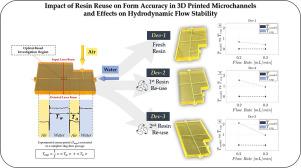树脂再利用对3D打印微通道形状精度的影响及对流体动力流动稳定性的影响
IF 3.7
2区 工程技术
Q2 ENGINEERING, MANUFACTURING
Precision Engineering-Journal of the International Societies for Precision Engineering and Nanotechnology
Pub Date : 2025-09-29
DOI:10.1016/j.precisioneng.2025.09.022
引用次数: 0
摘要
本文研究了树脂再利用对投影微立体光刻(PμSL)制备的微流控通道的形状精度和流体动力学稳定性的影响。采用新鲜、一次和两次可重复使用的光固化树脂批次制备了三种微光流体(MoF)器件。树脂再利用提供了一种可持续的方法,解决了与固化丙烯酸酯和甲基丙烯酸酯树脂相关的回收挑战,使其成为环保制造中越来越有效的选择。该装置通过空气-水双相流进行测试,以评估水动力稳定性。采用递归顺序和排列(RS/P)方法进行第一阶段无分布质量控制方法来评估通道宽度稳定性,同时利用傅里叶变换红外光谱(FT-IR)来跟踪重复使用树脂批次的化学变化。一项实验设计(DoE)研究分析了这些装置的流体动力学性能,结果表明,将流速提高到0.3 mL/min,可以提高所有装置的稳定性,克服光固化树脂重复使用造成的流动收缩效应。本文章由计算机程序翻译,如有差异,请以英文原文为准。

Impact of resin reuse on form accuracy in 3D printed microchannels and effects on hydrodynamic flow stability
This work investigates the impact of resin reuse on the form accuracy and hydrodynamic stability of microfluidic channels fabricated via Projection Micro-Stereolithography (PSL). Three micro-optofluidic (MoF) devices were manufactured using fresh, once and twice reused photocurable resin batches. Resin reuse offers a sustainable approach that addresses recycling challenges associated with cured acrylate and methacrylate resins, making it an increasingly effective option for eco-friendly manufacturing. The devices were tested through an air–water bi-phase flow to assess hydrodynamic stability. A Phase I distribution-free quality control approach employing recursive sequential and permutation (RS/P) methods was conducted to evaluate channels’ width stability, while Fourier Transform Infrared Spectroscopy (FT-IR) was exploited to track chemical changes in reused resin batches. A Design of Experiment (DoE) study allowed hydrodynamic performance to be analyzed for the devices, revealing that increasing the flow rate to 0.3 enhanced stability across all devices, overcoming flow constriction effects caused by the photocurable resin reuse.
求助全文
通过发布文献求助,成功后即可免费获取论文全文。
去求助
来源期刊
CiteScore
7.40
自引率
5.60%
发文量
177
审稿时长
46 days
期刊介绍:
Precision Engineering - Journal of the International Societies for Precision Engineering and Nanotechnology is devoted to the multidisciplinary study and practice of high accuracy engineering, metrology, and manufacturing. The journal takes an integrated approach to all subjects related to research, design, manufacture, performance validation, and application of high precision machines, instruments, and components, including fundamental and applied research and development in manufacturing processes, fabrication technology, and advanced measurement science. The scope includes precision-engineered systems and supporting metrology over the full range of length scales, from atom-based nanotechnology and advanced lithographic technology to large-scale systems, including optical and radio telescopes and macrometrology.

 求助内容:
求助内容: 应助结果提醒方式:
应助结果提醒方式:


